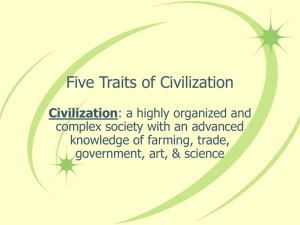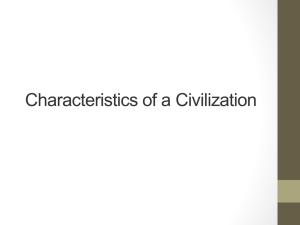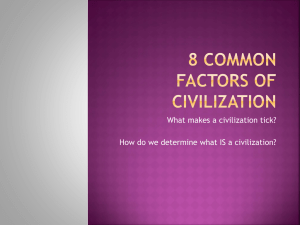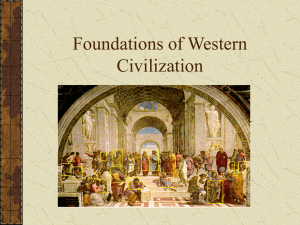Self-Colonization of Central and Eastern Europe
advertisement
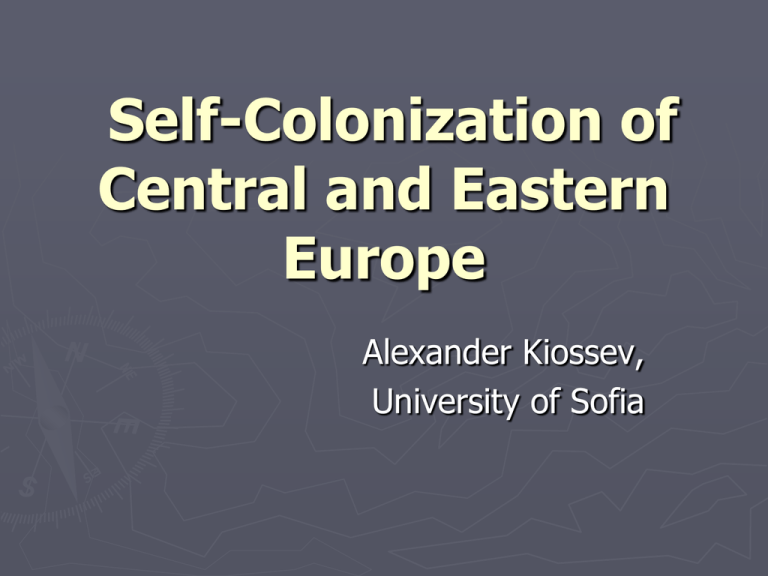
Self-Colonization of Central and Eastern Europe Alexander Kiossev, University of Sofia Part 1 The Post-Colonial Turn Introduction into the mess of concepts Colonization ► “…Colonialism is the establishment and maintenance, for an extended time, of rule over an alien people that is separate from and subordinate to the ruling power. It is no longer closely associated with the term ›colonization‹, which involves the settlement abroad of people from a mother country as in the case of the ancient Greek colonies or the Americas. Colonialism has now come to be identified with rule over peoples of different race inhabiting lands separated by salt water from the imperial center; [...] Some further features of the ›colonial situation‹ are: domination of an alien minority, asserting racial and cultural superiority over a materially inferior native majority; contact between a machine-oriented civilization with Christian origins, a powerful economy, and a rapid rhythm of life and a non-Christian civilization that lacks machines and is marked by a backward economy and a slow rhythm of life; and the imposition of the first civilization upon the second…” ► Emerson, Rupert: Colonialism. In: Sills, David L. (Hg.): International Encyclopedia of the Social Sciences. Bd. 3. New York, London: Macmillan 1968, pp. 1-5 Analysis of the definition ► ► ► ► ► ► ► ► ► ► Rule/domination over alien people Settlers (not necessarily) Distance (salt water) Alien-ness as “different race” (race distance) Alien-ness as cultural difference (cultural distance) Alien-ness as religious difference (religious distance) Technological difference (technological distance) Economic differences (economic distance) Different rhythms of life (anthropological distance) Imperial centre Questions ► What is the reason for connecting the “rule” with the “imposition of the first civilization upon the second”? Colonization is more than “rule” it requires imposition of superior civilization by a distant Empire. ► Why are differences presented as distance and distance – as superiority legitimizing the rule/imposition? ► The concept of superiority is split: religious (Christian) superiority vs. ethnic/racial superiority: reducible vs. irreducible (“natural”) superiority. ► What is the role of the “salt water”? It implies new type of sea transportation, a whole new manly world of sailors after 1492, risky voyages into the dangerous “open sea”, sea monsters, pirates, savages, adventures, exotic islands, “earthly paradises”… It implies imagination. What does “imposition of civilization” mean? ► ► ► ► ► ► I ► ► ► Import of institutions Power/knowledge: import of cognitive categories supporting the rule Import of practical know how Standardization/Normalization Import of legal frame Control and sanctions, menagerial skills: GOVERNMENTALITY import of religion and ideology: the Grand Narrative of progress, modernization and “the burden of the white man” Import of educational models Giving birth to new goals, dreams and longings: import of IMAGINATION What is “social imagination”? ► “Social imagination” usually implies a background intuitive knowledge, a body of stereotypes shared by a community: for Charles Taylor it is a widely shared pretheoretical reservoir of shared perceptions, both descriptive and prescriptive. ► Here we assume that usually this reservoir is structured as a historical narrative, which rules the dreams, longings and phantasma shared by the members of certain social group. ► Next assumption: Colonialism is not only rule over distant territories and alien populations: it is rule over the collective imaginations, over the reservoir of dreams, longings and phantasma both of the imperial and the colonized populations. It is imposition of a Grand Eurocentric Narrative. ► I.e. colonization is not only domination, it is hegemony: internalization of the hegemonic cultural values, narratives, images - self- stigmatizion and traumatic subjectivization. It is a longing for Ëurope, ”The West”, the “civilized World”. ► Modern colonization is marked by two dominant mirror longings – “the innocent Earthly Paradise” vs, “The Civilized World of Christianity, Progress, Enlightenment and Civilization” Between them are distance and “the salt water”. The postcolonial condition ► The process of decolonization after the WW II in Asia, (the Arab world, IndoChina, Indonesia) and Africa 1949 – 1965. The model cases – Indian independence 1947; the Suez Crisis 1956. The spread of the decolonization process all around the world, disintegration of all colonial Empires. ► Local Asian and African nationalisms, democracies and authoritarian regimes, political chaos, ethnic cleansing; success stories and unsuccessful states. ► The problem of the “colonial legacy” and “the Empire writes back”. The “europeanizined” local elites and their values. ► The anti-colonial intellectual resistance: Frantz Fanon and the program for “vomiting” of the European cultural values. Are alternative culture, alternative language (cultural codes) and alternative, non-European imagination possible? New national and pan-African literatures ► Cultural wars and the revision of the Eurocentric cultural canons – 1982 Stanford Postcolonial studies ► Inside the American and west-European university – academic critique and deconstruction of Eurocentrism ► Edward Said and “Orientalism” as critique of the Eurocentric power/knowledge about the East ► Homi Bhabha and the critique of hegemonic narratives. The split, hybrid and fragmented, “impossible” narratives of the colonized ► Gayatry Spivak and “The Subaltern cannot speak” ► The general problem – lack of authentic symbolic resource of the colonized: knowledge, narratives, language… imagination. Symbolic colonization. The Metaphor “Self-Colonization” ► This metaphor can be used for cultures having succumbed to the cultural power of Europe and the West without having practically been invaded and turned into colonies. Historical circumstances transformed them into an extracolonial “periphery”, lateral viewers who have not been directly affected either by important colonial conflicts or by the techniques of colonial rule. ► Yet, they are in a situation where they had to recognize self-evidently the foreign cultural dominance and voluntarily absorb the basic values and categories of colonial Europe. The result might be named “hegemony without domination”. ► The reason – the rule over imaginations trespasses the borders of the actual territorial colonial rule: In the world of late XIX centuries the colonial imagination started functioning as “Universal” (in fact, Eurocentric) Symbolic Order, valid everywhere - even in the few non-colonized corners of the. ► Short labels for this process of global conquering the various local imaginations: civilization process, progress, Modernity, westernization, Europeanization. Self-colonization, imagination and public discourse ► Important difference between factual colonial conquer and the conquer of desires, longings and hopes. The conquer of the imagination of the repressed (the dream about the West, Europeanization)– the ultimate form of Power. ► The maps of the real Empires and the Empires of the imaginations do not coincide; the ideal West is bigger than the real West. ► This form of Power – the conquer of imagination – could be called selfcolonization. The joke and the “Californication”. ► Self-colonizing imagination is not a psychological phenomenon: it is the inner structure of cultural production and the paradigm of the public discourse of the peripheral countries: it has public validity. Example 1: the first Bulgarian journal – the obsessive imagining of absence ► In 1842 Konstantin Fotinov (1790 - 1858), the creator of the first Bulgarian magazine Lyuboslovie (Philology), published a remarkable appeal which treats ardently and with pain all that lack of civilisation in the Bulgarians: ► "Where are their daily newspapers and magazines, or the weekly and monthly ones? Where are their artistic magazines, their rhetoric, mathematics, logic, physics, philosophy, etc., etc., which man needs more than bread? Where is their history, written in detail and widely spread among people, such as the other nations have and which would help us to stand side by side with the others and make the others aware of the fact that we are as verbal as the rest of God's creatures?" ► The Bulgarian press during the National Revival abounded in similar appeals dealing with the lack of civilisation. They all represent patriotic complaints about various shortages – about the lack of cultural institutions, literary or scientific achievements, good manners or great Bulgarian poets. Yet, in spite of their variety and heterogeneity one can see that all these complaints expressed much more a morbid awareness of the absence of a whole civilisational model rather than of some concrete civilisational achievement. Part II Modernization, Civilization, Europeanization – or SelfColonization? Imagination and practice ► During the XIXth century this “imagination of absence” (variants: of barbarity, orientalism, backwardness etc.) has been transformed into practical modernization programs. Important! –social imagination is not only imagination, it has real practical consequences. ► The sociological mechanism of this process: the local elites were educated in cross-border universities; back home, they took up roles as educators, revolutionaries, writers, journalists, tutors and started disseminating the Europe-centered colonial conceptual repertoire. ► They did it without violence or colonial “governmentality” but through the softer channels that had the leverage for captivating the imagination – stories, books, school classes and textbooks, popular literature, political propaganda and journalism. ► These early patriots without nations, self-styled national utopians and visionaries, introduced the notion of the „sovereign nation” and invented, by dint of studied models, local „historical traditions”. The dark side of the universal Eurocentric imaginary – the internalization of asymmetries and hierarchies ► Traditionally named “Europeanization” and „Modernization”, this process had – along with its indisputably positive effects – its dark side as well. ► Along with the values of Christianity, civilization, the Enlightenment, along with the placards of progress, liberty and revolution, the Europe-centered colonial were irreversibly cemented into the collective imagination of such groups. The trauma of being peripheral is internalized and transformed into a key element of the national identity building process. ► The notions of a European center and peripheries, of “masters” and „natural subjects”, “enlightened” and “non-enlightened” of a civilization source and its passive recipients, are taken to be natural, eternal and self-apparent; they became part of the „common cultural currency” and the public discourse of the new nations. Consequences: the traumatic identity building ► The new “imagined communities” (i.e. the modern nations) emerge in a power field : in an asymmetrical global imagined geography, which is strongly hierarchical and hegemonic: - they immerge in an Eurocentric World. ► Their collective identities are from the very beginning fatefully marked by their specific imaginary lоcation in this asymmetrical colonial Eurocentric world – they are either in the Centre (the focus of Civilization, Modernity and Progress) or in one or another of the variously stigmatized peripheries (backward, barbaric, exotic or shameful). ► Accordingly, the peripheral nations internalize their birth-stigma and perceive themselves trough it – a process of traumatic collective identity-building, painful and sometimes shameful collective subjectivation and sense of belonging. They perceive themselves as “cultures of absences and backwardness”. There is dialectical duality of shame and pride in the self-perception of such peripheral nations,: in their public sphere emerge two group of ideologists: apologists of “better westernizations” and “catching up with West ” – and the opposite trend, pride nationalists, “nativists” (zapadniki I povhveniki) ► Consequences – the imported, imitative and hybrid high cultures ► The artists and thinkers in such cultures are living with the sense of periphery and provincialism, they follow fashions, rarely – create fashions, ideas, paradigms. ► They struggle for recognition by foreign audiences and experts: the local (peripheral) recognition is not enough. ► Translation and translatability are crucial issue. ► Any attempt of “self-centering” in such cultures looks suspicious: it borders with nationalism, autochthonic ideologies, archaic nativism and xenophobia. Example 2: the longing for Bulgarian novel ► 1870 – 1890: The Sense of Absence of the Novel. Translation, “Bulgarizations”. genre Imitations: import of models. ► The First Bulgarian Novel (1989 Ivan Vazov) and the negative reaction of the newly born Bulgarian literary criticism: two accusations – 1. it is imitation 2. it is not a real novel. ► 1890ies. The rival literary context – the competing “non-Novels” – memoirs, autobiographies, short stories, journalistic documentary, vs. epic poems, lyric prose, lyrics. ► 1890 – 1914 Generational Quarrels, Non-recognition of previous novels, contested tradition, difficult canon building ► The need for recognition by foreign authorities ► Problems of translatability/non-translatability. 2012-2013 The case Gospodinov – Ruskov. The imported modern public institutions and their social status ► Similar to the situation in the real colonies, the institutions in the selfcolonizing cultures were not created in a process of incremental maturing and adaptation turning them into unquestionable and long-lasting, habitual practices. ► They were imported as prestigious European models and imposed by sweeping modernizing gestures of the elites who scraped them together and legitimized them in a broadly westernizing – and very often eclectic and inherently controversial – manner. ► In this process there always remained a whole lot of things impossible to import – the practical know how, the habits and routines, the well established ethos, the roles and rules in an everyday performance of an institution. As a result, the institutions were too often accommodated, used in unexpected ways to unforeseen ends, in line with bricolage patterns, i.e. they are hybridized. ► This in turn provided a special role to the public sphere: it had to live up to certain standards amidst public outcry, vitriolic criticisms and blazing philippics. Public institutions often found themselves under so much and so blatant pressure as to push them to the brink of loosing their credibility altogether. ► Example 3: modernization and “deOrientalization” of Sofia – the longing for “European” capital. ► 1880 – 1930 The modernizing struggle of the municipality. De-Orientalization of Sofia on symbolic and infrastructural level. Streets, public parks, pavement, street lamps, electricity, trams. ► Destruction or self-destruction of the old “turkish”marketplace, of the numerous mosques. ► Building of prestigious public buildings in European style” – national parliament, national theatre, university, banks, galeries, schools etc. Sofia 1879 The De-Orientalization process The De-Orientalization process 2 Sofia-Centre – 1900 Sofia-Centre – The National Theatre 1907 Sofia-Centre – the University 1930 Example 4: building and usages of Sofia’s first modern waterworks network ► By the time of the National Liberation (1878) Sofia populations (11 000) uses water from only 54 public fountains; there are just 3 Ottoman "experts” to take care for them. ► The first waterworks project was designed by the engineers Belov and Kubassov. 1884 - difficult financing, yet the municipality demonstrates “will for modernization” combined with a chaotic tactics of “economizing” and improvised adjusting off the technical realization of the project. The hybrid nature of the technological result. ► Tensions between political authorities and technical experts, corrupted “governmentality”, private interests shadowing the public interest and the technological standards. The real waterworks – cultural practices and usages ► Resistance by the peasant population surrounding Sofia: sabotages. ► The unexpected difficulties in maintenance of the waterworks network. Lack of educated technical personnel. ► The strange “water habits” of the Sofioters ( 1900 – population of 70 000) and the economic collapse of the modernizing project - the population, used to pre-modern attitude to water, doesn’t regard water as commodity, refuses to pay for it, it steals water with illegal pipes etc. The imagined ideological waterworks ► Municipality pride of the “technical miracle” ► Journalistic progress ► General enthusiasm about the symbol of approval and pride of the public The first phase 1884 -1900 The first phase 1884 -1900 – the Apostles of Progress The “Consumers” of Progress Consequences on the anthropological level – the status of norms and practices in everyday life ► Lack of factual colonial governmentality – bad management, imperfect rules of the game, local interests, weak control of results and misusages ► The imported norms (ideals, models, rules) remain non-imbedded in the everyday practices – they are too distant, too alien, too non-habitual. ► The habitual everyday practices are wild, resistant, ‘non-obedient’ – they tactically use the norms for their own purposes Example: the German Menscheschlange and English queue vs. the Bulgarian “опашка” ► The Queue – simple model of social institution: habitual formal rules, ruling roles, behaviors and mutual expectations ► Visibility of norms, usages and mis-usages ► Visualisation of order, disorder (chaos or transgression?) and sanctions Menschenschlange Menschenschlange (arbeitslose Informatiker in Zürich) English queue English queue Bulgarian “опашка” (literal meaning “tail”) Queue in front of Sofia’s bank Ukrainian case The western message of the queue image - the reproduced social order Опашка as the eastern image of poaching tactics Poaching tactics is conscious about the norm Interactions and tensions between high and popular culture ► It could be summarized as a stream of indignant criticisms alleging shortage of civilization from the top and torrent of irony, adaptations, adjustments, travesties, special uses, substitutions and hybrids from the bottom designed to evade or undermine the top. ► The masses, engrossed in their traditional way of living (with its own channels, agents and pace of modernizing and Europeanizing), never went the whole way in recognizing their Europeid elites with their modernizing projects and civilizing claims. ► The elites suffered the paradox of an inherent illegitimacy as being locally born, not „truly European”; on their part, they decried the „inferior human material” of the masses Discussion about the situation in Eastern Europe before 1989 ► Was the membership in the Eastern bloc under the leadership of the Soviet Union and during the Cold War a “colonial rule”? Or maybe not? Discussion about the recent situation in Eastern Europe ► How should we interpret the enlargement of EU: ► Accession? Colonization? Self-Colonization? None of this terms is adequate, we have to look for a different label What are the reactions of the different sociological strata of the population in your country toward the accession, what are the tactical East European uses and misuses of EU And “Europe”?





